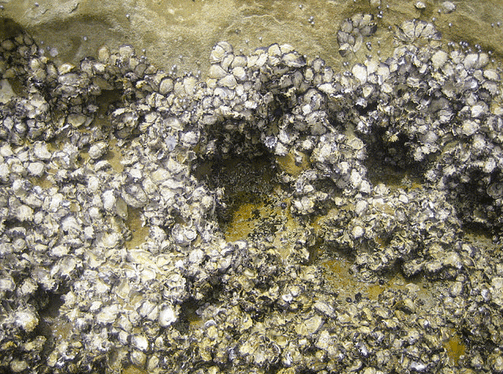After Sandy, looking at oysters as a way to protect vulnerable coastlines
Oyster beds add stability to coastal areas. (Photo by Jessica James.)
There are many ideas for protecting New York from devastating storm surges in the future, barriers and gates, for example.
Writer Paul Greenberg has an idea of his own, and it’s not something you might expect: oysters. Centuries ago, oysters were a fundamental defense for the city, Greenberg wrote in an op-ed for The New York Times.
Greenberg lives in lower Manhattan, in an area that lost power from Sandy’s storm surge.
“When you walk downhill (on Broadway), past a certain point you start to see this waterline on buildings, and if you peer into the windows of bars and restaurants, it just looks like there was a huge bar fight with a lot of mud, so you see chairs and tables thrown all over the place,” he said. “One place, a famous fish market restaurant called the Paris, had literally a stream of beer bottles coming out the door.”
And yes, people were stopping to drink them. But to keep people from picking flood beer bottles out of the street again, Greenberg says we should turn to oysters.
“When they are born they are little free-swimming larvae, and they set upon other oyster shells and they build shells of their own,” he explained. “If you do this enough times, time and time again over 7,000 years, which is what the time period is that we’re talking about — you end up with reefs.”
Turns out, thousands of years ago, New York was ringed by oyster reefs, much like coral reefs protect islands and coast lines in tropical areas.
In addition to protecting the shore, they also break up waves as well. Over the last 400 years, however, we’ve hunted the oysters practically out of existence near New York harbor. And rather than return the shells to the water, for new oysters to grow from, we turned them into lime for use in building materials.
“It’s almost like opening up a bleeding wound for the sea to come rushing back in,” Greenberg said.
The destruction has been so complete, oysters wouldn’t be able to rebuild their colonies without human intervention. While water quality has improved, the currents are too strong for their reefs to develop.
A consortium of different organizations including Bay Keeper, Hudson River Foundation and a few others have built these test reefs to see if they can get oysters growing again. The Army Corps of Engineers laid down some rock, and on top of that attached spat-on shell, which is baby oysters that have already bonded to a chunk of shell.
“The idea is that to get enough of these reefs planted throughout the harbor,” Greenberg said, “they would produce a lot of shell and you could maybe get the momentum going so that you could start to reclaim some of this reef structure that we’ve lost.”
Once upon a time these reefs were 10, 20, even 30 feet high, Greenberg said. And while it would take a long time to get that sort of protection from an oyster reef, these barriers will build themselves, ideally, once they get a little jumpstart.
“They will build themselves higher and higher until they’re really at the height that they should be to ease the storm surge,” Greenberg said. “The oyster doesn’t like situations where it’s exposed to pounding sea. So when it creates reefs, it creates calmer water, which allows for more oysters to grow.”
Of course New York will still need ship lanes. Which means there will need to be some sort of human intervention as well to protect the harbor from storm surge. But Greenberg hopes that oysters and human creations can work together.
Under one theory, a series of habitats would be created around the harbor, where the oysters could grow. If they were setup properly, they could be shaped to provide for ship lanes naturally.
Greenberg’s optimistic that a proper oyster reef system would have helped lessen the impact from Sandy — and may be helpful when a future storm roars ashore.
“I’m not an engineer, I’m a writer, but the engineers and the scientists I’ve talked to like this idea and I don’t think that the Army Corps of Engineers would have invested their time and money into this project if they didn’t think that there was some sort of potential,” he said.
